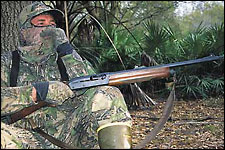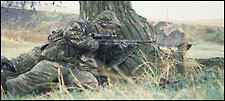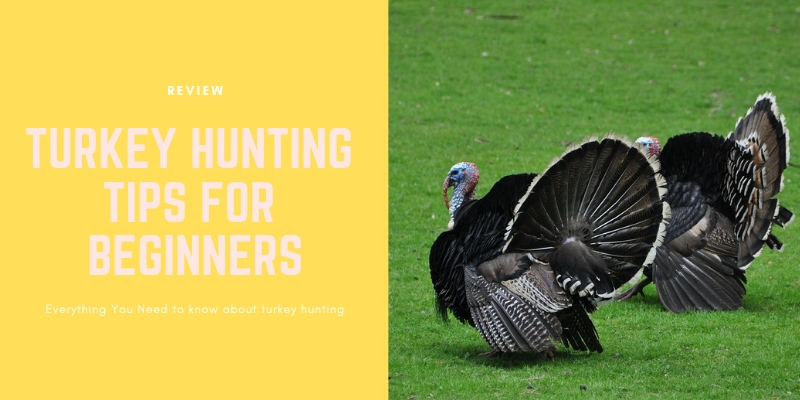Turkey hunting tests your wits as they’re rarely tested in modern life. It takes an understanding of the turkey itself – the only upland game you flirt with, not flush.
Wild turkeys are as wary and high-strung as whitetail deer. Their eyesight and hearing are acute.
Stalking a mature tom close enough for a shot is all but impossible and can be very dangerous if other hunters are in the area. Instead, select a strategic spot and talk him into range – mimicking the calls of an unmated hen, or sometimes the gobbling of a rival tom.
In springtime, the main hunting season for gobblers, turkeys are intent on courtship. The birds’ urge to breed is triggered by increasing daylight hours, which stimulate the sex hormones of the toms.
A mature tom, or gobbler, assembles a harem of two or more hens. His gobbling and strutting attract them, which also serve to intimidate lesser toms.
A year-old male, or jake, may strut or gobble but usually doesn’t mate. Dominant toms hook up with the first mature, receptive hens and perform most of the initial breeding.
Early in the spring, a gobbler expects the hens to come to him. This is the hen-gathering time, which may last several days or a week, and is the first of two “gobbling peaks”.
Once the toms are encircled with harems of hens, gobbling activity decreases.
At daybreak, gobblers will sound off only a few times from their roost, if at all. During this time, when the mature toms fly down to mate with their multitudes of female partners they will clam up and may only gobble a few times.
Toms are referred to by many, while acting in this manner, as being “henned up”.
In a short while, a week or so, the impregnated hens will begin visiting nests to lay one egg each day. This will generally happen in the late-morning hours and will take nearly two weeks for a hen to lay a full clutch of ten to twelve speckled eggs.
The incubation period then kicks in for the hens and they desert the toms for tending to their eggs. Gobblers tend to still be lovesick and will scout the woods for new mating opportunities.
At this time, the gobbler is more willing to pursue any hen he hears at a distance and will gobble long and hard once again. This is the second “gobbling peak” and it may last from a few days to a week. Any of these days where the old boss gobbler is searching for new hens is a prime time to hunt!
A tom and his harem roost close to each other at night, occasionally in a secluded ravine or over a creek or swamp. At first light, they fly to the ground and then the toms get down to the business of mating. He attends first to the harem and afterwards, he will be more likely to respond to your overtures.
This period after daybreak is the most productive for hunting. After toms fly down and mate with all of the available hens, he will be most vulnerable – be patient and you may have a chance to score!
As the day wears on, the turkeys move around to feed. At dusk they roost again, returning in many cases to the same vicinity or even to the same tree.
Beginner Turkey Hunting Tips
I can’t begin to tell you how many tom turkeys I’ve taught a thing or two during the past 15 years. Consider one gobbling bird my wife and I went after last spring.
Just a little closer, I thought, as we carefully inched forward to find a suitable place to set up. Then I spotted the perfect tree only 30 yards ahead.
We never got there.
Instead, we heard the dreaded “flap-flap-flap” sound of a turkey beating a hasty retreat. Not only had the turkey spotted us trying to make that last move, but we’d also “educated” him in the process.
Don’t get me wrong. I don’t believe a gobbler is capable of reason. However, he has strong survival instincts, and an incident such as the one I just described will keep him on an even sharper edge than usual for days, which often makes him a lot harder to work than he normally might be.
We probably do more things to tip off gobblers to our presence than we could possibly imagine, but I’ve come up with five pieces of advice to help you avoid the most common mistakes hunters make–errors that complicate the already difficult task of calling in a mature spring tom.
5 Turkey Hunting Tips for Beginners
1. Avoid the rush
Bumping birds-as my wife and I did–typically occurs when a hunter gets in a hurry and feels he needs to get just a little closer.
Proximity certainly counts when calling a gobbler: The closer you are to him, the less distance he has to travel to get to you. The less distance he has to travel, the more you build his confidence and the better the chance that something won’t go wrong before he walks into gun range.
Unfortunately, all too often we cross the line between not close enough and too close.
Consider a turkey that has heard your calls. He answers enthusiastically. He’s curious and staring intently in your direction, but you’re moving in and he busts you. There’s a tom you won’t be able to work for a while.
Although it’s possible to bump a bird at any time of the day, it probably occurs most often at dawn when toms are on the roost.
When moving toward a roosted gobbler, always remember that a bird in a tree can see much better than can one on the ground. He’s also anxiously awaiting the arrival of a hen, which is precisely why he carefully scans the forest floor below him.
Foliage is another factor.
If spring arrives late, and the woods haven’t greened up, you can’t get as close to a gobbler as you might be able to otherwise. Note, too, that when there is no foliage, a bird will usually sound closer–whereas heavy foliage makes a turkey sound farther away.
Never assume that you should always set up 100 or 150 yards away just because it’s some rule of thumb.
It’s better to start from one place–and move closer once you know you can–than to move forward when the situation is risky. You always have a chance of calling up a bird from a considerable distance, but you don’t have a chance of luring in a bird that has spotted you.
2. Plan for the first contact
I’ve always believed that the best setup is the one you have at hand.
We’ve been taught that we should find a tree wider than our shoulders where we can see anything approaching from a safe distance–and you should definitely do so whenever possible because it reduces the chances that another hunter will shoot you in mistake for game.
However, if I insisted on always setting up in these places, I would have killed far fewer turkeys. Staying on the move to look for a perfect setup after you’ve raised a gobbler often leads to spooking the bird. If a bird gobbles, and he’s close, you have to choose a location close at hand or back up to find something better.
That’s why it’s important to think before you call.
A gobbler doesn’t expect a hen to be in places where he wouldn’t go. For example, you’d be well-hidden if you set up in the middle of a huge logjam, but a gobbler knows a hen probably wouldn’t be there if she’s searching for a mate.
Granted, I’ve shot many turkeys in thick spots, and sometimes I’ve had to make a gobbler hunt for me, but I prefer setups where I can see about 40 to 50 yards so the gobbler will have to come in that close to see the hen–and it means he will be in or nearly in gun range once he gets there.
If he can see for 60 yards or more, he may hang up. If it’s so thick that he has to get within 20 yards to see the source of the hen calls, he’ll likely ignore you.
In field situations, it’s best to avoid setting up in cover situated in the middle of a field. A gobbler will often move close enough to scan an open area for a quick view, and if he doesn’t see anything, he leaves.
So how can you make sure your first setup will be a good one?
Avoid random calling; call only when you’re in an area that lends itself to killing a gobbler. If you’re in thick brush or other undesirable place but still want to check if there are any toms within earshot, use a locator instead of a turkey call.
That way the turkey might give away his location and not be interested in where you are, giving you the chance to find a good setup from which to start him.
When you’re hunting through an area where you think you could work a bird successfully but haven’t heard anything yet, choose a tree or other solid backdrop, call and wait a few minutes before moving on.
Many gobblers have been educated when they sneaked in quietly and caught a hunter moving–or when they were so close and came in so quickly that the hunter never had a chance.
3. Let ’em come
I don’t believe a gobbler can be educated by hunters’ turkey calls. Sure, you must sound something like a turkey, but hens make all sorts of sounds, and they have individual voices as well.
On the other hand, I do believe that you can screw things up if you call at the wrong time.
Most of us like to call a turkey every time he answers; I know I do. When a bird answers, I’m anxious to send him another sweet yelp or two. But when a bird is coming–and he often is once he begins answering calls–over-calling can cause him to put on the brakes.
The key is to recognize when a gobbler is on his way.
Once you know he’s moving toward you, I prefer to stop calling.
I remember a few years ago when I was hunting in Oklahoma with Realtree hunter Joe Drake. I jumped on an eager-sounding bird late in the morning with one call after another. The bird gobbled furiously at first and then went silent.
Fortunately, after hanging up for a while, he sneaked in. After I shot the gobbler, Drake explained that my continuous calling nearly stopped the bird from getting to us. I knew that he was right and that I was lucky.
4. Mix it up
Pay close attention to how quickly a gobbler answers your call. A delayed response may mean you’re not giving him the sound he wants to hear.
I know of several birds that responded late–or not at all–to common yelps. These same turkeys, though, gobbled without hesitation when they heard clucks, purrs or an aggressive cutt.
Yelps are the most popular hen calls used, and rightfully so, but they can raise suspicion in a gobbler–particularly late in the season.
I don’t believe a gobbler is capable of deciphering turkey calls; he can’t determine if the call is coming from a real hen or hunter. In fact, many turkey hunters sound better than real hens.
However, as the season progresses, some gobblers may come to associate a flat, mechanical-sounding “yelp-yelp-yelp” with danger because it’s the sound he has heard whenever something went wrong.
Always be prepared to give a turkey a call other than the common yelp. It might be okay to start with a yelp, but never believe that it will be the only call you need to get him into gun range.
A cluck, purr or another sound may be what it takes to build his confidence.
5. Stay loose
If there’s one sure way of putting a gobbler you’re working on high alert, it’s by remaining in the same location. Earlier I discussed moving too much and bumping birds. True, you have to use common sense when moving on a gobbler and when setting up to keep from being spotted, but don’t plan to remain in that location too long.
It’s a turkey hunter’s nature to stay put and let it all happen. After all, you found the right place, and the gobbler doesn’t know there’s anything else around except your turkey talk. If you stay put, you know you won’t spook the turkey. Why take the chance on moving and risk finding another setup as good as this one?
Any gobbler that hears turkey talk coming from the same location for a long period is probably not going to show up. He might gobble furiously and make you think he will, but odds are he’s standing back there and waiting for you to come to him.
In a case such as this, you may have to move. Granted, you should give a turkey a chance to show up where you first called to him. However, I can honestly say that I’ve killed few gobblers from my initial calling location. Sometimes it was the second spot, sometimes the third, and there have been times that I couldn’t tell you how often I got up and moved.
I sincerely believe that changing positions has helped me to coax gobblers into gun range. Just how far you need to move depends on the location of the gobbler. If the bird is close, consider short moves of 20 yards or so. It doesn’t have to be toward the bird, either. He will know you moved, even it’s just a small, lateral move.
A gobbler knows that a turkey is going to move. It might stay in the same proximity but not in one precise spot. I typically give a bird 20 minutes or so to make a move toward me before changing setups. If the bird isn’t coming, I call to get a response to learn his precise whereabouts. Then, if the coast is clear, I move a short distance and call again. This tactic really fires up most gobblers.
6. Slow it Down
For a sport that carries such a woodsy texture, so much of turkey hunting occurs on the open ground. Depending on where you live, you’re likely to encounter food plots, meadows, clearcuts, pastures or even entire valleys that will in some way impact your pursuit of a gobbler.
Granted, there might be one or two occasions during a lifetime of turkey hunting that you’ll spot a bird out in the open, sit down, and have it walk straight to you, but for the most part, you’re going to earn any bird that’s standing in plain view.
On many occasions, empty terrain will hinder you in one way or another. You’ve just got to accept that when a gobbler is out there in the open, it’s using two primary strengths–its senses of sight and hearing–to its advantage.
Any direct approach on a gobbler that has a hundred yards or so of flat, uncovered ground around it will be futile, and you’re left with really only two viable schemes:
- You can back off the open ground and try to call him into a spot of your choosing
- Or you’re going to have to outflank the gobbler and set up along its travel route.
In either scenario, you’ll find that dealing with an open-country gobbler is an entirely different discipline than working a bird in the woods. In a lot of ways, it’s more deliberate than intense, but it’s every bit as discriminate.
Brad Harris, who’s as respected for his prowess as a turkey hunter as for his association with Lohman Game Calls, has hunted much of the same country I have, and he stresses the need to slow things down when you’re on a bird that you’ve spotted out in the open.
“In the big woods, you cover a lot of ground, and are always moving, and calling, and setting up,” he says. “In the open, you’re doing the same things, but you have to slow down ’cause you get busted more often.”
When you consider that a turkey whose eyes and ears are unobstructed by any form of cover is going to entertain a certain sense of security, you don’t want to upset that by letting it know you’re there.
Be patient to the extent that you remain totally concealed. And remember that when you’re up against an open-country gobbler, time might be measured in days, not hours.
7. Observe all You Can
Once you’ve located a gobbler on a vacant patch of land, gather a quick read of what information is immediately available.
Is the gobbler with a hen? Are there other birds nearby?
Then whip out the binoculars and start getting patient. Study the gobbler’s tendencies, and pay particular attention to when and where he enters and exits the field.
At the same time, you need to learn all you can about the terrain.
Since staying concealed outranks any other requirement in your approach, determine what route you’re going to have to use to get to your chosen set-up spot.
Even if staying hidden means going miles out of your way, be willing to go the extra distance.

Missourian Ray Eye, who’s as impressive a turkey hunter as I’ve shared camp with, relies heavily on what he refers to as “turkey tunnels.”
His homeland features entire systems of eroded creek bottoms, and they often provide all the concealment he needs to slither into position.
When he locates a gobbler, he starts thinking in terms of what tunnels he must follow to get as close as he can to the bird.
And even if things don’t go exactly as hope on the first day, don’t consider it time wasted.
As Harris notes: “Even if you don’t kill a bird, you can learn his patterns by watching him. That will help you make precise setups on day two or three.”
Those of us who are without an abundance of creek bottoms or ditches to crawl around in have to use whatever cover we have at our disposal: berms, ridges, tree lines or even knee-high brush. Spotting a bird before it spots us offers such an advantage, but only when we can use it to full effect.
8. Calling Strategies
Again, when you to call to a gobbler that’s enjoying the comfort of a secure location, the last thing you want to do is make him nervous.
Often, the easiest way to do that is to lack believability–call from where a hen wouldn’t be, or in any other way come across as fake.
Sometimes you can turn him off by being too aggressive, other times by being too timid. Eye tends to lean more heavily on the aggressive side, and it’s fun to watch him work a bird. When he locates a strutting gobbler out in the open, he’ll pick his path to it, and call hard up to within 100 yards of the gobbler.
“I want that gobbler to know I’m coming in after him,” Eye says.
“Then I’ll come right up under him.”
Eye remains just as aggressive when he attempts to steal a gobbler away from a live hen by calling loud, hard and often. His theory is based on the premise that if he can sound like a hen that’s more amorous than the one the gobbler’s currently with, something positive might happen.
Harris, also a world-class caller, suggests experimenting with the various makes of calls. Volume is often going to be an issue in open country, since such terrain is so susceptible to sound-dampening wind.
The safest way to play it is to start out easy at first, then get progressively more aggressive until you start drawing the proper response. If you can spend enough time with the same batch of birds, you’ll figure out how best to call to them.

|
Both Harris and Eye agree that a hunter’s chances of calling in a bird are greatly increased when he has the opportunity to set up decoys. When you’re calling to a gobbler in a field, you’re so much more credible when he looks your way and sees, particularly, an arrangement of jake(s) and hens.
“Open-country birds rely more on eyesight, so if they look out and don’t see what they want to see, they won’t respond as well,” Harris says.
Additionally, by exploiting a gobbler’s breeding and territorial instincts, you don’t have to be quite as concerned about the quality of your setup. When he has the opportunity to place decoys, Harris won’t hesitate to position himself at the bend of a creek, along with a fenceline or at some other such place he would never feel comfortable in if it weren’t for the dekes.
“You can always get good setups in open country when you have the decoys out,” he says.
But no matter what tricks you pull on a gobbler, give him time to work. There’ll be occasions when the best efforts fail, but most of the time what should happen will. And there’ll always be those rare occasions when you just get lucky.
Late-Season Blues
Stop and consider for just a moment why many turkey hunters hate seeing the arrival of the late season. The turkey hunting gets downright tough; many birds turn and walk away from even the sweetest hen yelps.
You can thank “educated” gobblers for the late-season blues.
To beat them, you may have to change your methods. Keep in mind that as the season wears on, turkey behavior is changing. The ardor that characterized the early part of spring may be cooling; in some areas, the reverse is true–the end of hunting season can coincide with intense gobbling.
alloutprodux.com




